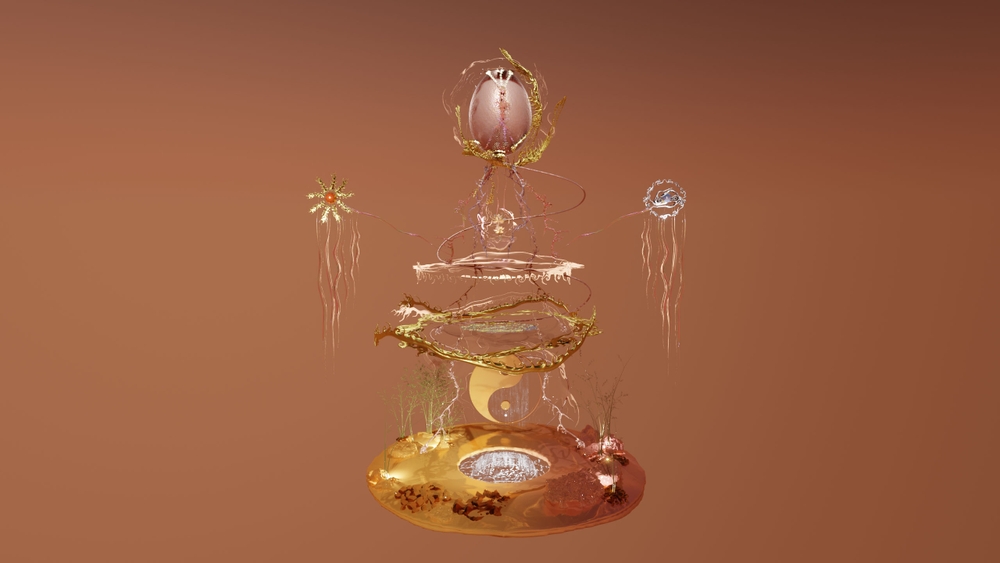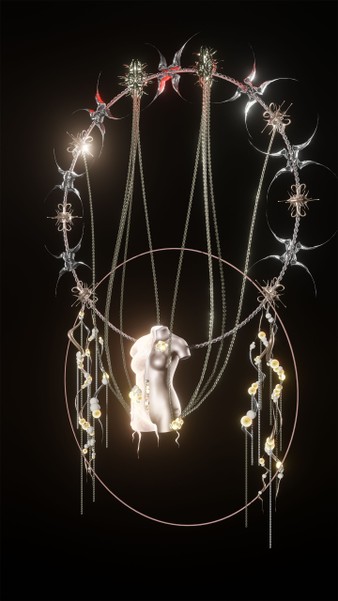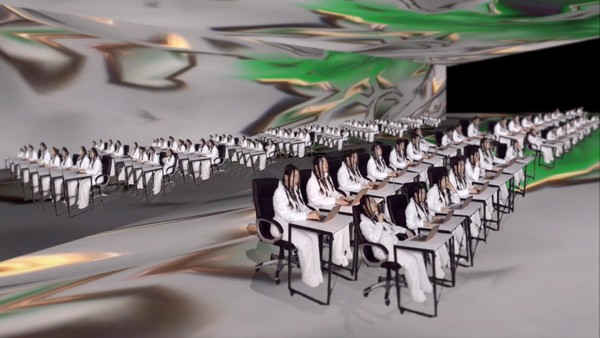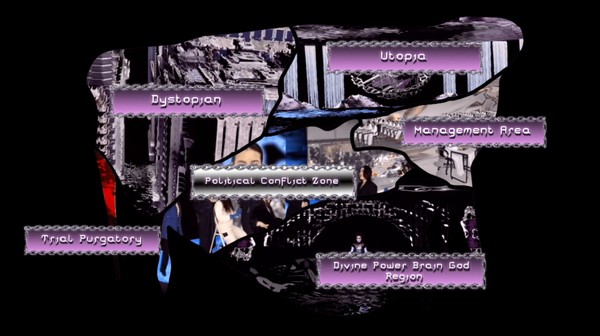Based in Tāmaki Makaurau, Xi Li 李曦 is an interdisciplinary artist from Harbin, China. Her practice includes film, digital images, photography, sculpture, installation, performance, 3D animation, VR and game design. Over the past few years, Xi has developed a body of work that explores the possibilities and existential questions posed by digital media and digital cultures — as complex manifestations of the knowledge systems, beliefs and subcultures that shape individual identity, and society at large. She received a Bachelor of Photo Media from Whitecliffe College of Arts and Design in 2019. In 2021 she received a Master of Fine Arts at Elam School of Fine Arts at the University of Auckland and was awarded the Iris Fisher Scholarship. In this interview for Aotearoa Digital Arts Network with curator Sophie Davis, Xi discusses the trajectory of her recent work.
Sophie Davis: Xi, you mentioned that the foundation of your early practice was quite performative. Could you talk a little bit about how you started working in digital space?
Xi Li: As a “digital native”, creating in a digital space comes so naturally to me. My life has been surrounded by all kinds of images, cultural symbols and digital content. These direct, symbolic, ubiquitous images surrounded and even overwhelmed me, so much so that I became interested in digital imagery and video creation from an early age. I have been teaching myself photography, Photoshop and the use of video editing software since I was a young teenager, and I was also very interested in self-identity and the psychological narratives that relate to fashion, Internet culture and its subcultures.
In my earliest attempts at practice, I often tried to document my daily life through photography, or to act out and mimic certain images or looks to explore the question “who am I?” For example, I would often create a unique look for myself, using my image as an element of a digital collage, or interact with some device or prop in front of the camera.
My early work Visions (2017) is an installation of countless strips of white paper and projections hanging from the roof. These strips of paper contain a series of cynical and manic handwritten self-reflections. The flamboyant words are echoed in the images of the characters that emerge. A red-painted me is mapped onto these strips of paper in a dynamic collage. The whole installation is like a madcap ramble about my adolescence.
And in the short film From a Peeper to a Practitioner (2017), I wore a burglar mask hat, dressed in glamour and presented several eccentric and abstract physical performances. I dance indoors, crawl on the floor with projected light, climb trees in the dark, and wrap handwritten notes around my body…it plays out a rough narrative on themes of self-view, faith, culture and fashion.
These earliest practices are my starting point. The intention is that I want to turn to a deeper inner self through the expression of my outer self. I tried to guide and establish my identity and the concept of belonging through self-presentation and performance. It’s like a process of rising self-awareness and complex psychological states, and also my instinctive curiosity about the world. In the process, I realised I could record or shape something by combining digital technology and photography with performative content — whether it being symbolic still-life photography, self-portrait photography, stylised documentary images, digitised collage images, or new media installations based on photos and videos. I was considering different digital techniques and methods of expression based around digital photography.
SD: How does this foundation connect to your current work?
XL: Lens and digital-based images, performances, videos, moving images and installations are still the main directions of my work, and I have also extended my practice to 3D animation, virtual reality, sculpture and more.
My current work is based on a methodology of artistic practice developed through philosophical research and critical thinking. I am addicted to the discovery of things, with a focus on a technology-filled life, the globalised cyberspace, the construction of personal identities, the origin of the things we desire, our virtuality, our reality, and stories with common values in the social imagination. My approach is to explore and examine my own experiences and interests, using myself as an example to echo and reflect on the processes by which the world has shaped us and our dreamy-yet-precarious contemporary life. This development has not only continued my exploration of the idea of self, but has also turned to questioning, reflection and critical cognition based on my life experience.
My long-term project Brain Island (2019-ongoing) is a good example of a hands-on transition from my early work to the present. This project revolves around the exploration of issues of identity formation and ideology, and currently includes several different works that are still being developed. It includes a film essay exploring existentialism in a contemporary context, a video work based on the concept of heterotopia proposed by Michel Foucault, and a series of adventure games where the player is inside the worldview of the “Brain Island” through patterns of text and interactive design.
SD: In your work, you create urban/fantasy environments. What kind of feeling do you want to create with these spaces and where do you draw your imagery from?
XL: I consider the spaces that I create to be dynamic, relatively ordered narratives. My scenes and environments are often shaped around the metaphors and symbols embedded in a particular theme or system of potential content. They are deconstructions of my subject matter, an unfolding of my mind map, and a concrete presentation derived from research. I want to combine the infinite surge of imagination within digital art with the precision of logical and rigorous research.
Secondly, these spaces are different levels of my perception, a view of myself that includes self-reflexive imagery. My purpose is not to stay on the surface of imagination, but to imagine a certain kind of order that is both kitsch and solemn. It is both a virtual place (unreal) and a real one (reality), containing things in our minds that have been discovered by us or have not yet been noticed.
My different projects produce different spatial imagery. For example, in Spirit Ether (2021), I examine the reality of globalisation dominated by capital logic, depicting a fetish civilisation that has been developed by consumerism as a ‘society of the spectacle.’ Capital logic is infinitely expanded and diffused. It not only gives us the meaning of social coherence, but also constructs the entire contemporary grand narrative and dominates our collective and individual imaginations. In Spirit Ether you can see exotic, hybrid and bizarre aesthetic texts without any actual nationality or historical point of reference. These buildings and urban environments seem to be a hyper-historical and hyper-cultural fusion in a concrete temporal context; all sculptures and models are nevertheless appropriated in an orderly way, arranged with precision and categorised to exist in different areas. They become networks: that shared system of meaning that permeates the internal realm of reality and spirituality.
The VR video game work The Idol Reveal: From Infatuation to the Mysterious (2022) in the long-term project “The Idol Reveal” (2021-ongoing) is a self-psychoanalysis of idol worship in contemporary celebrity and Internet culture from the perspective of symbolism.
In my practice I’m not so interested in idol worship as a fanatical social phenomenon. Rather, my practice is a subject exploration and an experiment based on the theory of “objet petit a”, the object-cause of desire in psychoanalytic theory. The Idol Reveal: From Infatuation to the Mysterious presents a vision of the idol worship universe and a consciousness practice of self-inquiry, and consists of three separate scenes. The structure of these scenes is based on my research diagrams and depicts the three stages of consciousness that I go through in the process of making work, including the many changes in symbolic systems and meaning structures. Each scene has a separate order of operation, and the various mythological and religious elements, totems and imagery in these scenes are inspired by changes inherent in idol worship from ancient times to the present day. The audience is invited to enter this labyrinth-like but rigorous place, and walk through the blurred and delicate experience and complex inner imagination of the subject’s fantasy.
In the animation video work Being, Becoming 所是,所成 (2022), I have attempted to reintegrate elements of my culture by creating different scenes that transcend time and space. I see this work as an existential enquiry into cultural boundaries. I have expressed my transcultural aspirations within the framework of Chinese Confucianism, Taoism and Western philosophy. In this work, I have created a female digital avatar and an ‘Egg of the East’ floating on a pink sea. I also have presented an ‘Ethical Structure of Self-Cultivation’ representing my culture and a fantasy and dreamy ‘Ideal Realm’ based on my imagination and observations of the natural world.
These ‘surreal’ works are actually a precise kind of ‘realism’. The fantasy environments I create are ideal; they are building boundaries, deconstructing and reintegrating my new experiences, reflections and critical thinking into one blueprint after another. They interweave and contain our identities, cultures, politics, values, and can internally generate many narratives about individual and group histories, memories, myths, fantasies and beliefs.
Xi Li 李曦 is an interdisciplinary artist from Harbin, China, based in Tāmaki Makaurau. In 2019, she received a Bachelor of Fine Arts in Photo Media from Whitecliffe College of Arts & Design. In 2021, she received a Master of Fine Arts (with first-class honors) from Elam School of Fine Arts at the University of Auckland.
Xi Li’s creative practice spans across various fields, including films, animations, sculptures, 3D printing, games, virtual reality, installations, performances, and diagrams. She explores the complexities of subjective and collective experiences, as well as the aspects constituted by fantasies and desires. Xi Li is dedicated to merging theoretical research with artistic practice, constituting expressions and challenges that link the two realms. She often works within research frameworks such as psychoanalysis, semiotics, and postmodernism, presenting self-mythology or critical narratives on themes like subjectivity, identity, technology, the body, space, pop culture, and globalization.
Xi Li has exhibited her works in various locations across New Zealand, Australia and Austria. Her recent solo exhibitions include “The Transcendence Labyrinth of Idols” at Te Tuhi, Auckland, “The Generation of The Hyperreal” at The Arts House Trust, Auckland, and “Spirit Ether” at The Physics Room Contemporary Art Space, Christchurch, New Zealand.
Sophie Davis is a curator at Te Whare Toi o Heretaunga – Hastings City Art Gallery. She has worked across a range of public and not-for-profit spaces for contemporary art in Aotearoa including recently at Dunedin Public Art Gallery of The Centre of Contemporary Art (CoCA) in Christchurch. From 2016-20 she was Director/Curator of Enjoy Contemporary Art Space and prior to this, was Assistant Curator at The Physics Room and co-founded North Projects (2014-16), an independent art space in Ōtautahi Christchurch. She is particularly interested in exploring relationships between art, labour and collective discussion through queer and feminist thinking.








